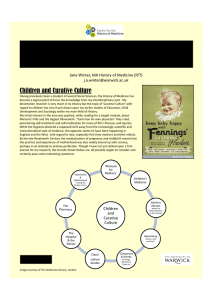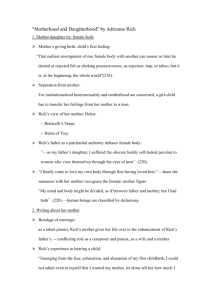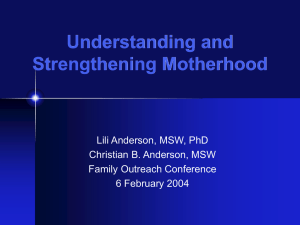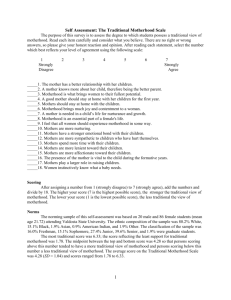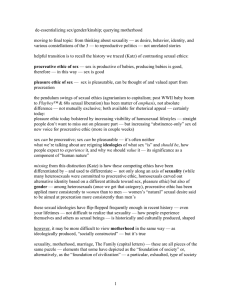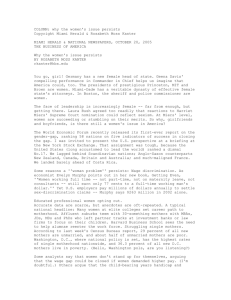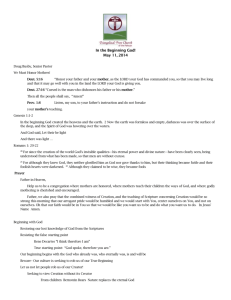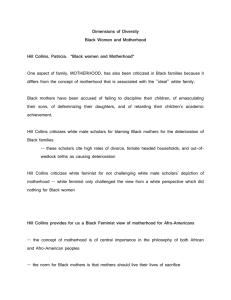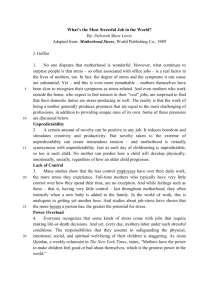Celebrating Mother*s Day In the early 20th Century
advertisement
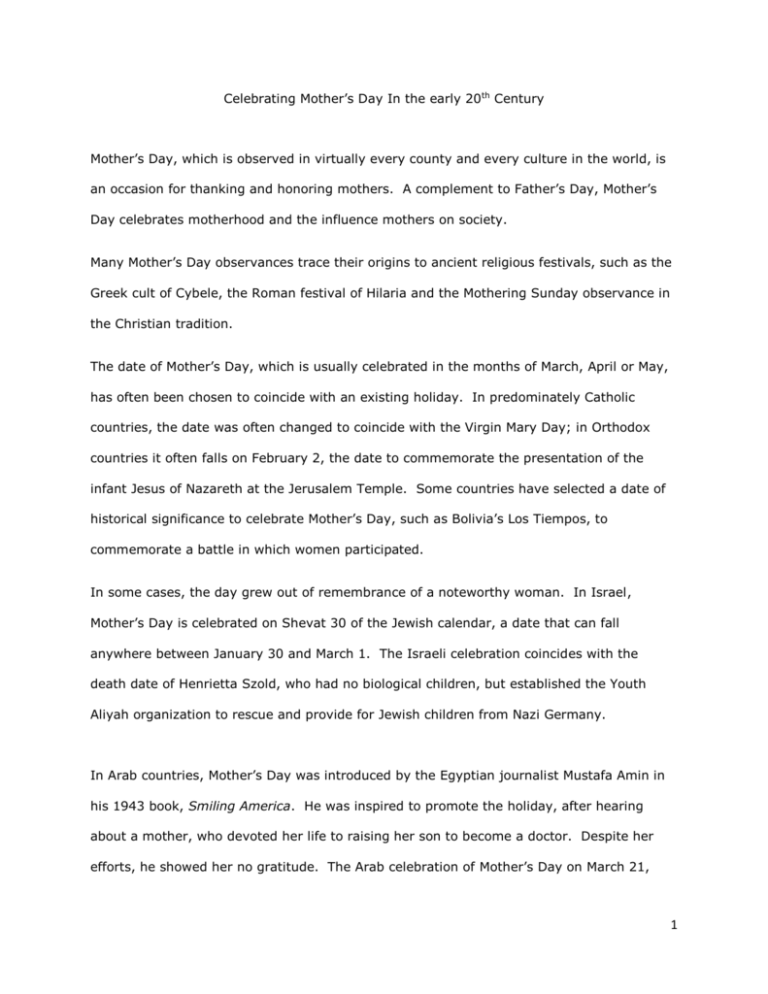
Celebrating Mother’s Day In the early 20th Century Mother’s Day, which is observed in virtually every county and every culture in the world, is an occasion for thanking and honoring mothers. A complement to Father’s Day, Mother’s Day celebrates motherhood and the influence mothers on society. Many Mother’s Day observances trace their origins to ancient religious festivals, such as the Greek cult of Cybele, the Roman festival of Hilaria and the Mothering Sunday observance in the Christian tradition. The date of Mother’s Day, which is usually celebrated in the months of March, April or May, has often been chosen to coincide with an existing holiday. In predominately Catholic countries, the date was often changed to coincide with the Virgin Mary Day; in Orthodox countries it often falls on February 2, the date to commemorate the presentation of the infant Jesus of Nazareth at the Jerusalem Temple. Some countries have selected a date of historical significance to celebrate Mother’s Day, such as Bolivia’s Los Tiempos, to commemorate a battle in which women participated. In some cases, the day grew out of remembrance of a noteworthy woman. In Israel, Mother’s Day is celebrated on Shevat 30 of the Jewish calendar, a date that can fall anywhere between January 30 and March 1. The Israeli celebration coincides with the death date of Henrietta Szold, who had no biological children, but established the Youth Aliyah organization to rescue and provide for Jewish children from Nazi Germany. In Arab countries, Mother’s Day was introduced by the Egyptian journalist Mustafa Amin in his 1943 book, Smiling America. He was inspired to promote the holiday, after hearing about a mother, who devoted her life to raising her son to become a doctor. Despite her efforts, he showed her no gratitude. The Arab celebration of Mother’s Day on March 21, 1 was initially resisted by Egyptian President Gamal Abdel Nasser. Eventually, he accepted the holiday, first celebrated in Egypt in 1956. Afterward, the holiday spread to other Arab countries. The State Library’s Rare Collections Library contains a pamphlet commemorating the Fourth Annual observance of Mother’s Day in the United States on May 13, 1917. A “Memorial Meeting” was held in Pittsburgh, Pennsylvania, sponsored by the Mothers’ Pension League Fund of Allegheny County. For the occasion, Dr. S.B. McCormick, Chancellor of the University of Pittsburgh, offered a tribute “to womanhood and motherhood.” He described these overlapping concepts, which define those who bear and nurture children and love and support their husbands and families. He admits that, although a mother is often “accustomed to sink her personality in the members of her household, to give herself in service to her husband and to children . . . that her first duty before she is a wife and mother is to herself.” Despite the service and sacrifice that she is asked to render, McCormick says a mother’s primary obligation is “to develop her own personality, just as it is the duty of all of us to respect her personality, as the most sacred thing in all the world.” Consequently, he asserts that a woman ought to have the same education as a man, since she is “the mother of men.” She must have the same opportunities to develop herself and her aptitude for her own “peculiar service” just as a man. The second function of womanhood, according to McCormick, is “wifehood”, since marriage is the foundation of the home, and the only condition by which men and women can form a “perfect and complete unit”. In his view, only the conjugal relationship and the family it establishes can nurture human society. It seems “obvious” to him that no individual apart from his fellows, can develop into a “complete” individual any more than the human race can “develop into completeness of being,” without the union of man and woman in the institution of the family. He says that God has established this bond, “for the preservation of the race and the building up of civilization.” 2 The third function, the relationship in which womanhood is made “complete”, is motherhood, a most sacred thing. In motherhood a woman must enter “the valley of the shadow of death,” and to do so willingly! For such a willing sacrifice, we lift her up to a high place and crown her “Queen of the World, the mother of men.” For this reason the word “’mother’ becomes the dearest term we can use in our present relationship.” The thought of Mother touches all human life; and is most effective in forming human character, “the finest character men can achieve.” For this reason, it is right to pause once each year to pay tribute to our mothers. In a wartime era that emphasized “power and . . . the will to power” as the basis of national existence, McCormick countered that other things—“tenderness, and love, and inspiration, and devotion, and fidelity”—are so much more essential. In his view, the things worth living and dying for are not things like power, but instead things “of the soul, justice, and righteousness, and tenderness, and love and service”. Such things make life worthwhile. They make us humane, and focus on she, who is Mother. Therefore, he called on his listeners to honor motherhood. The Mothers’ Pension League, who sponsored the May 13 Memorial Meeting of 1917 had been organized in August, 1913 to lobby the Pennsylvania Legislature for a bill to compensate deserving mothers in the Commonwealth. The League disavowed the notion of soliciting charity for mothers. Instead, the basis of the Pension idea was that by assisting a mother to raise her fatherless offspring, Pennsylvania merely promoted the welfare of “future citizens”. The Mothers’ Pension Act was passed in the Pennsylvania Assembly in the 1913 Legislative session. The Rare Collections Library is open to students and researchers by appointment, MondayFriday, between the hours of 9:00 am and 12:00 noon, and 1:00 pm-4:00 pm. To make an appointment, contact Dr. Iren Snavely by telephone at 717.783.5982, or by email at: 3 irsnavely@pa.gov. The Rare Books reading room is also open periodically for tours to the general public and to Pennsylvania Commonwealth employees. 4
